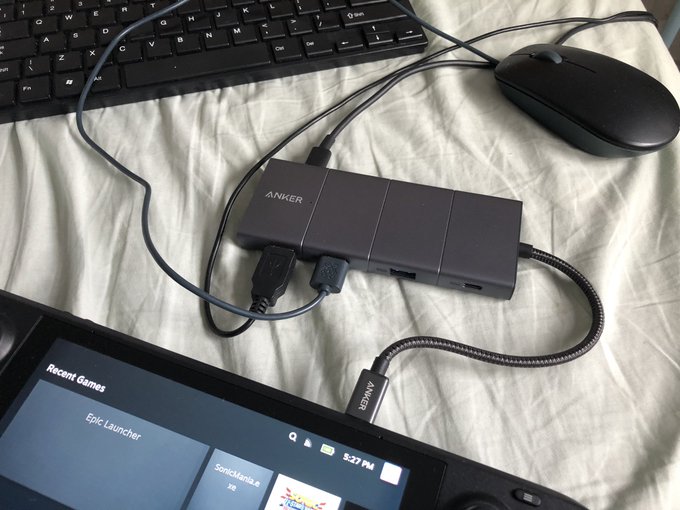Anker PowerExpand 11-in-1 USB Type-C PD Hub Review
While I’ve failed to get my hands on Anker’s 13-in-1 USB Type-C dock, the 11-in=1 Hub is a leaner and more portable alternative. It has turned out to be a better companion to my little 11” Star Lite than the chonky desktop dock could ever have been. There are two reasons for this: it fits into my bag, and it supports pass-through for the Lite’s existing USB Type-C power supply.
I’ll be honest, I’m not the biggest fan of USB Type-C Hubs. I found something I liked in CalDigit’s SOHO– one of the few without a captive cable and with sensibly placed ports- but otherwise they all seem to have the same fatal flaws: short, short captive cables and a weird port layout.
The PowerExpand 11-in-1 is no exception. It’s tricky to place nicely next to my laptop, and with wires escaping out of – potentially – all four sides (one of which the upstream USB Type-C cable is permanently fixed to) it can get untidy quite quickly.
Would it hurt to have the USB Type-C input and output on the same side? Would it hurt to put USB ports, video ports and Ethernet on the back. Then audio, USB Type-C and microSD/SD on the front? Anker seem to manage this with their desktop docks, but for some reason USB Type-C hubs with any quantity of ports all seem to favour this compromised, thin, terrifyingly laid out nightmare fuel. Don’t believe me? Go and stick “11 port USB Type-C hub” into Google Images right now. I’ll wait. Finished throwing up? Well let’s move on.
Terrible, terrible layout aside, I can’t ignore the fact that Anker’s 11-in-1 hub is very, very useful. With the Star Lite having a meager two USB Type-A ports, a Type-C that’s usually tied up by power, a fairly frustrating microSD card reader and no Ethernet port it’s left wanting. Anker’s dock brings a slew of extremely useful functionality in a portable package that complements this diminutive notebook well. The usefulness of full-sized HDMI and DisplayPort connectors cannot be overstated- while the Star Lite has a mini HDMI I somehow rarely have the right cable handy. Indeed these proved their worth when I found myself hot-desking at Pimoroni HQ with a dinky laptop and a chonky DisplayPort cable that otherwise would not have been the best of friends.
Similarly the 11-in-1 hub is a godsend to have around while I’m tinkering with the Steam Deck. I don’t have a Bluetooth keyboard (or at least not one that isn’t terrible) so I hook up a Raspberry Pi keyboard and mouse and power via the dock. It’s also handy for plugging in USB storage, SD cards and so forth without moving the Steam Deck from it’s dinky little 3D-printed stand (thanks Chris!).
This @AnkerOfficial 11-in-1 USB-C hub is working nicely with Steam Deck! pic.twitter.com/yuu3XBzrjW
— Phil Howard (@Gadgetoid) June 10, 2022
The dock is also compact enough to fit in my WaterField Designs case, sitting neatly in the pouch between the Steam Deck’s hand-grips.
Enough room in the @SFBags case for the USB Type-C hub! The AC adapter is sort of awkwardly stuffed in the pouch at the back though! pic.twitter.com/biUg0hPqQf
— Phil Howard (@Gadgetoid) June 10, 2022
Ethernet is similarly extremely useful. It’s no secret that I do a not trivial amount of actually productive work on the Star Lite and while it’s expected that a laptop is used wirelessly it’s more often than not sat on my office desk and connected- via Anker’s dock- to an Ethernet cable. Let’s be honest here- the Star Lite’s WiFi and my extremely cheap router do not like each other and a solid Ethernet connection makes the difference between a smooth, uninterrupted SSH connection to my development Pi’s and a frustrating, freezing nightmare.
3.5mm audio is an odd duck. I don’t really use wired headphones anymore since the liberation of Bluetooth far outweighs its occasional hiccups. Furthermore, are there really any laptops without a decent, integrated, 3.5mm audio jack? Heck, even the M1 MacBook Air sports one now. 3.5mm audio on a dock makes sense because you’ll leave it connected to your desktop PC speakers (people still use those, right?) but on a portable hub like this? I’d toss it to the wayside and prefer a less spaghetti port layout.
Similarly the combo of microSD and full-sized SD is a common choice. I understand exactly why. There are still plenty of full-sized cards out there, but I can’t help but want to pretend that there aren’t, and aim for a hub that’s a little more opinionated and a little less kitchen sink.
But that’s the rub. Any complaint I can level at Anker’s 11-in-1 Hub amounts to complaining that I have a Swiss army knife when all I wanted was a corkscrew. The sheer breadth of ports and functionality easily outweighs the rather cumbersome and absurd layout and there’s a great deal of value in knowing you have that flexibility in a pinch.
Did I mention you can use the microSD and full-sized SD card slots simultaneously? This is actually more useful than I give it credit for backing up, imaging or upsizing SD cards.
So, in a rather hurried conclusion, aside from the slightly weird style and the frustrating port spaghetti this 11-in-1 hub – or one like it -is an essential companion for a modern, port-starved, ultra-thin notebook. It’s effectively the one-dongle-to-rule-them-all and the Anker branding- as near as I can tell from using their products for many years- carries with it some assurance that it’s not going to be garbage.
And, indeed, I’ve been using it across several devices now for a few months and it’s been a champ! Grab it from Amazon and maybe I’ll get some coin for your trouble.


